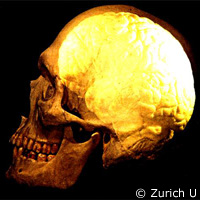Big brain, small stomach? Not any more
Contrary to what the expensive-tissue hypothesis says - that some tissues need more energy for their resting metabolism than others - researchers in Switzerland have discovered that when the brain of a mammal increases in size, the digestive organs do not become smaller. Presented in the journal Nature, the study was funded in part by the SYNTHESYS ('Synthesis of systematic resources') project, which has received EUR 7.2 million under 'Research Infrastructures' Theme of the EU's Seventh Framework Programme (FP7). The University of Zurich researchers have also found that the potential to store fat usually works together with relatively small brains, except in humans. Three key components are responsible for people's ability to use more energy: communal child care, better diet and their ability to walk upright. The tissue of the brain uses up a lot of energy. If an animal species evolves a larger brain than its ancestors, the demand for more energy can be met by either securing more sources of food or by exchanging it for other functions in the body. The human brain is three times bigger than that of the great ape, making the need to use more energy stronger than that of Man's closest relatives. While most people have long thought that early humans redirected energy to their brains because of a smaller digestive tract, the Zurich researchers showed how mammals with relatively large brains usually have a larger digestive tract. 'The data set contains 100 species, from the stag to the shrew,' says lead author Ana Navarrete, a doctoral student at the Anthropological Institute and Museum at the University of Zurich. The team compared the size of the brain with the fat-free body mass. 'It is extremely important to take an animal's adipose deposits into consideration, as in some species, these constitute up to half of the body mass in autumn,' explains the paper's senior author, Karin Isler of the University of Zurich. However, the size of the brain does not correlate negatively with the mass of other organs, even if it is compared with fat-free body mass. But the storage of fat is involved in the evolution of brain size. While not a great deal of energy is consumed by adipose tissue, fat animals use up a lot of energy to carry extra weight. This is particularly true when an animal runs or climbs. This energy is then lacking for potential brain expansion, according to the researchers. 'It seems that large adipose deposits often come at the expense of mental flexibility,' Dr Isler says. 'We humans are an exception, along with whales and seals - probably because, like swimming, our bipedalism doesn't require much more energy even when we are a bit heavier.' The team points out that the fast brain-size increase and the associated rise in energy intake took off some 2 million years ago in the genus Homo. Says Dr Isler: 'In order to stabilise the brain's energy supply on a higher level, prehistoric man needed an all-year, high-quality source of food, such as underground tubers or meat. As they no longer climbed every day, they perfected the art of walking upright. Even more important, however, is communal child care.'For more information, please visit: University of Zurich: http://www.uzh.ch/index_en.html Research Infrastructures: http://ec.europa.eu/research/infrastructures/index_en.cfm?pg=esfri
Countries
Switzerland

